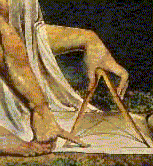|
It might be worthwhile stating a few facts about complex numbers. Let l = (u, v) be a complex number, where u is the real part of l (denoted Re(l ) = u) and v is the imaginary part (denoted Im(l ) = v). The complex number l = (u, v) can be written as l = u + iv where i is the imaginary operator, i = Ö -1. If l = u + iv is a complex number, then the l- = u - iv is called the "complex conjugate" of l . Note that if Im(l ) = 0, then l = u = l -, i.e. the complex conjugate of any real number is that real number. Note also that the sum of a complex number with its complex conjugate is a real number, i.e. l + l - = (u + iv) + (u - iv) = 2u and the product of a complex number with its complex conjugate is a non-negative real number, i.e. l l - = (u+iv)(u-iv) = u2 + v2 (as i2 = 1). The "absolute value" or "modulus" of a complex number l = u + iv is the non-negative real number |l | defined by |l | = Ö (u2 + v2). Note that the definition of absolute value for a real number is no different as |u| = Ö (u2) when the complex number is itself a real number. We can represent complex numbers and their conjugates as ordered pairs in the plane defined by a real and an imaginary axis as shown in Figure 1.
Introducing polar coordinates r, q by setting u/r = cos q and v/r = sin q where r = |l |, then the complex number l = u+iv can be written as l = r(cos q + i sin q ). A complex number l expressed in this form is said to be in "polar form". We want now to define the exponential function, ¦ (l ) = el where l is a complex number such that the laws of exponents hold, i.e. exey = ex+y and e0 = 1. If l = u + iv, then we want eu+iv = eueiv, so we have to define eiv. This can be done as follows: let eiv = cos v + i sin v. Thus, for l = u + iv we obtain el = eu(cos v + i sin v). Thus, if l is real so that v = 0, then el = eu(cos 0 + i sin 0) thus, as cos 0 = 1 and sin 0 = 0, then el = eu. Similarly we can note that if we have two complex numbers, l = u + iv and l ¢ = u¢ + iv¢ , then elel¢ = eueu¢ (cos v - i sin v)(cos v¢ + i sin v¢ ) = eueu¢ [(cos v cos v¢ - sin v sin v¢ ) + i(cos v sin v¢ + sin v cos v¢ )] = eu+u¢ [(cos (v + v¢ ) + i(sin (v + v¢ ))] = el+l ¢ by the properties of cosine and sine. Similarly, we can note that el = e-l = e0 = 1. Thus, the laws of exponents hold. Finally, as l = u + iv can be expressed in polar form l = r(cos q + i sin q ) but, recall, eiq = cos q + i sin q , then l can also be expressed as l = reiq where r = |l |. Thus the complex number l can be expressed in the following four forms:
so, given u and v, we can determine r and, confining attention to [0, 2p ), also q . Similarly, knowing q and r, we can find u and v. Finally, De Moivre's theorem can be obtained by noting that l n = (reiq )n = rneinq = rn(cos nq + i sin nq ).
|
All rights reserved, Gonçalo L. Fonseca


